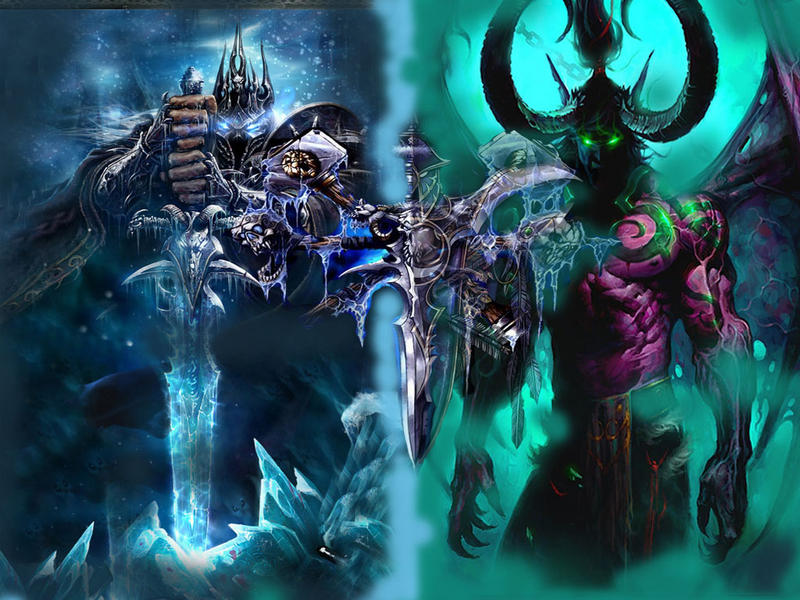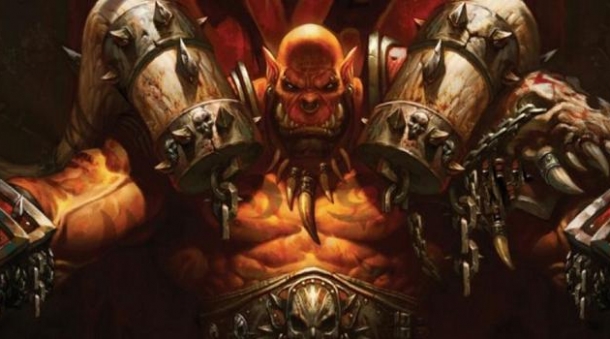Last updated on July 18, 2013
Thank goodness for World of WarCraft news to light up my spirit a bit! Blizzard, apparently, doesn’t even NEED E3 anymore, and Public Test Realm patch notes turn into their own news frenzy/story/misleading narrative. Of course, the first thing we observe comes from class changes, new features and the like, but we really benefit from dataminers who uncover new character models and information on new raid/lore content. I love the WoW lore, and that love isn’t unfounded; it develops as you quest and do tasks in the world, and Blizzard’s writers juggle a lot of different story notes. Some don’t emerge for years, and that story thread still remains relevant and eventually emerges. Patterns and parallels being to develop.
Prepare for lots and lots of World of WarCraft lore talk. Warning in advance!
For those not in the know: World of WarCraft’s story has, for the last four expansions, set a villain in place. The first two, Illidan and Arthas, were characters well-established in the WarCraft universe. We knew Illidan as a night elf who continually vowed for power and thought himself the greatest sorcerer and warrior of all time. Unfortunately, his constant quest for power drove him to the brink of madness – he fought his greatest foes at the behest of a greater power, only to find himself utterly defeated. His mind, unable to grapple with this, toppled over the edge and he found himself on a foreign planet (literally and mentally). Surrounding himself with forces due to his increasing paranoia, it took a band of heroes to finally take the man down.
Subsequently, we had Arthas, the man who pushed Illidan over the precipice. Arthas originally lived as the successor to the king of the human forces in WoW’s lore, but found himself driven to defeat a foe who continually ran away. He, too, found himself on a quest for power that led him to become an undead Death Knight who served the Lich King, an ethereal being which controlled the undead legion of Azeroth, WoW’s homeworld. Unlike Illidan, however, Arthas does it willingly and with purpose. He becomes the new Lich King and fuses with the old one. He shows no remorse at all for his actions, continue to rationalize his constant slaughter of innocence and the use of human souls to power his armies. When you finally reach him, the pathology continues even unto death, wherein death becomes his final release from the slavery of power.

After that, unfortunately, WoW hit a bit of a snag as far as big lore villains. Simply put, they didn’t have any to work with from WarCraft III, which contributed much to the game’s feel and environment. Instead, Deathwing from WarCraft II became our new foe, with mixed results. He did not show us any complications of a rise to power or anything of the sort; Neltharion the Earth Warder found himself corrupted by the Old Gods – think Cthulhu mythos – and he went insane. Cue big giant dragon with metal teeth that cackles and destroys things. Although he looks incredibly cool and he did, indeed, wreck things up, he didn’t have much of a character arc. As a villain, he felt the equivalent of a kaiju film monster, and other “good” characters picked up the slack.
Now, with Mists of Pandaria, Blizzard found themselves in a position with unlimited freedom and no boundaries as to where the story could go. The main theme of this expansion, in contrast to a focus on good or bad things trying to save/kill everything, is the notion of conflict. Pandaria, the titular continent, exists as a magical land in a host of other magical lands. Emotions manifest themselves in physical and spiritual ways that literally affect the world. Negative emotions, especially, produce creatures known as “Sha”, which can possess and manifest in harmful ways depending on your emotion.
At the beginning of the expansion, war intensifies between the two factions you play – the Alliance, and the Horde. The Alliance consists of those we would call “good” races as per Tolkien’s Lord of the Rings – Humans, Dwarves, Elves, etc. The Horde, on the other hand, take the traditionally “evil” races – mostly anything that doesn’t look human, but Orcs, Trolls, Undead, Tauren (humanoid bulls). Neither of them represents all-good or all-evil; they exist in that murky space in-between two unified nations fighting for resources, conquest, or just the pleasure of conflict. The Alliance exists more like its namesake, while the Horde appeared more as a family of outcasts who banded together against a world that didn’t like them.
It shouldn’t surprise you that this Alliance/Horde conflict turns into a race war, with each side denigrating the other’s skin color or origins. The Horde experiences its own bouts of internal conflict, as the Orc Warchief (leader) Garrosh Hellscream turns himself into a racist bigot who creates the “true Horde” where all races becomes subservient to his own. This becomes disconcerting to the troll leader Vol’jin, who eventually leads an open rebellion against Garrosh (with the help of Alliance agents, no less). But the real cap, here, is that these negative emotions come to life on Pandaria, the new battlefront. Sha pop up everywhere, infesting the new races who landed on Pandaria. Pandaria wasn’t accessible until recently, as the Mists that surrounded it mysteriously disappeared. So why did they disappear? Pride.
Sha manifest themselves according to certain emotions; they feed and exacerbate them. They are a great foe, simply because they cannot be permanently contained (think Cold War-style containment). One must keep their emotions in check, but that’s hard when the seven great Sha feed on Doubt, Anger, Hatred, Violence, Despair, and Fear. These emotions naturally occur, but on Pandaria they become deadly. Yet, in the game, Pride has not emerged yet. It remained hidden even after the defeat of the other six, and we all wondered why.
Pandaria’s obviously a giant reference to China, what with the great wall and all, and even having long lines of Emperors who ruled it. The most important one was Emperor Shao Hao, who “purified” Pandaria of its ills and imprisoned the Sha ten thousand years before our arrival. By doing so, we hear that he shrouded the land in Mist and protected it from events in the outside world. Yet that’s not really the case. Events turn to history, history turns to legend, and before long the original story is long forgotten.
So World of WarCraft reveals the actual answer in a quest titled “Path of the Last Emperor”. You lead a Pandaren seer, Hao Pham Roo, up a mountain top while he flouts dialogue such as this:
Heh, do not get angry with the elements. Violence is their nature. I conquered my own anger long, long ago.
My, you are strong! When I was young, I might have doubted that we could do this. But now, I have no doubts at all.
Such wind! Such cold! Once, it would have filled these old bones with despair. But on this day, I am filled with hope.
Such a patient one! When I was young, I would have hated this task. Nowadays, I am filled with love.
Do not fear the heights, as I did when I was young. Fear can drive us to terrible deeds. Ah, but I see that like me, you have learned the lessons of courage!
And if you’re not seeing the pattern here, you’re not paying attention. Each one represents a specific Sha, and each shows its opposite as imagined by WoW’s writers. It’s a pretty brilliant play, and works perfectly. So we segue into the last one:
Ah, here we are. Oh – oh, these old bones are tired. More than you can imagine. You surprised me. I expected a hero such as yourself to balk at the task of carrying an old man up a mountain. Most are too proud.
We find this seer might know more than he lets on. Why mention these things at all? Because Shao Hao, to let the cat out of the bag, talks of himself the whole time up the mountain path. You help him, but he gives you advice on how to fix yourself. It’s an interesting contrast, simply because Sha manifest themselves in all these emotions, but we realize that something underlies our own conquest of negativity: pride in having conquered them. If that isn’t the point, then the dialogue that follows makes no sense:
I was going to teach you a lesson, but instead, it is you who have taught me. You see, when I was young… when I was young… when I was young… I was EMPEROR.The realm you see all around you was mine to command. I conquered my doubts, my fears, my anger… I buried all of it within the land. But I held on to one vice. The one sha I never conquered. PRIDE. My pride cloaked this land in mists! I thought we were better than the rest of the world. I thought we could solve our own problems. But for ten thousand years, we stagnated, our doubts and fears buried in the land, rising up to fester whenever we allowed them. Pride. It is the most insidious of sha. It is good until it is bad. And then it is more dangerous than all the others combined. Beware of Pride! Be humble! The world is plunging into chaos. Old enemies must work together. Proud races must admit they need help. Things are going to get worse before they get better. Only by working together can we overcome the darkness. All that stands in our way… is pride.
Of course, that’s an old theme for any literature. The Bible cites Lucifer’s sin as pride, thinking himself greater than God and bringing followers along with him. There’s obvious parallels in this story, granted, but there’s a deeper context to this in the story of Garrosh Hellscream, the leader (soon to be deposed as a raid boss, no less) of the True Horde, so called.

